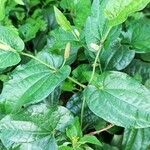| Therapeutic use
|
Anorexia (flower), Antipyretics (flower), Aphrodisiacs (flower), Appetite stimulants (flower), Asthma (flower), Bronchitis (flower), Cholera (flower), Colic (flower), Diarrhea (flower), Dysentery (flower), Dyspepsia (flower), Emollients (flower), Epilepsy (flower), Expectorants (flower), Fever (flower), Flatulence (flower), Gonorrhea (flower), Gout (flower), Hemorrhage (flower), Hiccup (flower), Laxatives (flower), Low back pain (flower), Stomach diseases (flower), Immunostimulant (fruit), Analgesics (fruit), Anemia (fruit), Anthelmintics (fruit), Antirheumatic agents (fruit), Asthma (fruit), Bronchitis (fruit), Cholagogues and choleretics (fruit), Cholestasis (fruit), Colic (fruit), Coma (fruit), Common cold (fruit), Cough (fruit), Digestive system diseases (fruit), Diuretics (fruit), Dysentery (fruit), Epilepsy (fruit), Fever (fruit), Flatulence (fruit), Gallbladder diseases (fruit), Giardia (fruit), Gout (fruit), Hemorrhage (fruit), Hiccup (fruit), Hoarseness (fruit), Hypnotics and sedatives (fruit), Menstruation-inducing agents (fruit), Paraplegia (fruit), General tonic for rejuvenation (fruit), Respiratory tract diseases (fruit), Sciatica (fruit), Scorpion stings (fruit), Skin diseases (fruit), Sleep initiation and maintenance disorders (fruit), Sleepiness (fruit), Snake bites (fruit), Stomach diseases (fruit), Asthma (leaf), Cough (leaf), Abdominal pain (root), Analgesics (root), Anthelmintics (root), Anti-infective agents, local (root), Antirheumatic agents (root), Appetite stimulants (root), Asthma (root), Bronchitis (root), Cardiotonic agents (root), Cholestasis (root), Colic (root), Coma (root), Common cold (root), Cough (root), Digestive system diseases (root), Diuretics (root), Dysentery (root), Dyspepsia (root), Emollients (root), Expectorants (root), Fatigue (root), Fever (root), Flatulence (root), Gallbladder diseases (root), Gout (root), Hemorrhage (root), Hiccup (root), Hoarseness (root), Laxatives (root), Low back pain (root), Menstruation-inducing agents (root), Pain (root), Paraplegia (root), General tonic for rejuvenation (root), Respiratory tract diseases (root), Sciatica (root), Scorpion stings (root), Skin diseases (root), Sleepiness (root), Snake bites (root), Splenic diseases (root), Stroke (root), Tetanus (root), Abdominal pain (seed), Asthma (seed), Bronchitis (seed), Cholera (seed), Constipation (seed), Cough (seed), Diarrhea (seed), Gonorrhea (seed), Hepatitis, viral, human (seed), Lung diseases (seed), Malaria (seed), Neoplasms (seed), Splenic diseases (seed), Tongue diseases (seed), Headache (unspecified), Alterative (unspecified), Analgesic (unspecified), Aphrodisiac (unspecified), Apoplexy (unspecified), Asthma (unspecified), Bactericide (unspecified), Bile (unspecified), Bite(Snake) (unspecified), Bladder (unspecified), Bronchitis (unspecified), Carminative (unspecified), Cholagogue (unspecified), Cholera (unspecified), Coma (unspecified), Cough (unspecified), Diarrhea (unspecified), Diuretic (unspecified), Dysentery (unspecified), Dysmenorrhea (unspecified), Dyspepsia (unspecified), Emmenagogue (unspecified), Epilepsy (unspecified), Fever (unspecified), Flux (unspecified), Frigidity (unspecified), Gall (unspecified), Insomnia (unspecified), Kidney (unspecified), Larvicide (unspecified), Leprosy (unspecified), Lethargy (unspecified), Masticatory (unspecified), Megalospleny (unspecified), Myalgia (unspecified), Paralysis (unspecified), Parturition (unspecified), Phthisis (unspecified), Psoriasis (unspecified), Puerperium (unspecified), Pyrosis (unspecified), Sedative (unspecified), Snuff (unspecified), Spice (unspecified), Spleen (unspecified), Sterility(Female) (unspecified), Stimulant (unspecified), Sudorific (unspecified), Tetanus (unspecified), Thirst (unspecified), Tonic (unspecified), Toothache (unspecified), Tuberculosis (unspecified), Tumor (unspecified), Urogenital (unspecified), Vermifuge (unspecified), Astringent (unspecified), Catarrh (unspecified), Coryza (unspecified), Gastralgia (unspecified), Placenta (unspecified), Stomachic (unspecified), Beri-Beri (unspecified), Abortifacient (unspecified), Anemia (unspecified), Anthelmintics (unspecified), Aphrodisiacs (unspecified), Appetite stimulants (unspecified), Ascites (unspecified), Cardiovascular diseases (unspecified), Colic (unspecified), Diabetes mellitus (unspecified), Digestive system diseases (unspecified), Dysentery, amebic (unspecified), Dyspnea (unspecified), Hemorrhoids (unspecified), Memory disorders (unspecified), Nootropic agents (unspecified), Increase physical endurance, strength and stamina (unspecified), Sinusitis (unspecified), Splenic diseases (unspecified)
|

